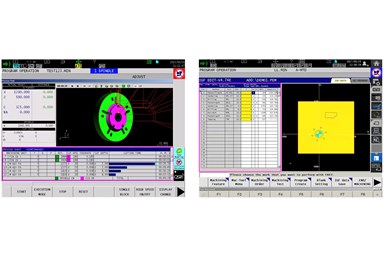Okuma Launches Conversational Programming on Select Machines
Okuma has launched its Advanced One Touch-Interactive Graphics Function (AOT-IGF) conversational programming software on select machines, increasing usability and speeding up setup times.
Share






Select machines from Okuma America Corporation’s core product line now come equipped with the company’s Advanced One Touch-Interactive Graphics Function (AOT-IGF) conversational programming software. AOT enables shops to achieve faster setup times, increase machine productivity and create simple part designs without needing highly-trained programmers.
With onboard AOT, a graphical user interface provides step-by-step instructions that guide operators through the process of selecting material type, tooling, processes and cutting motions for the desired part design. The system then simulates the cutting process in a 3D graphical view before it exports the NC (numeric control) program, minimizing concern about correct program syntax.
Okuma says a key benefit of AOT is that it allows shops to get the most out of their machine tools while avoiding typical manufacturing pitfalls. Specifically, it allows users to create and edit part designs directly at the machine tool, import 2D drawings straight into AOT using the DXF (drawing exchange format) import function and import NC code straight into AOT from CAM (computer-aided machining) systems or other programs. Users can also simulate the cutting process and show a cutting time study, program conversational files and run the NC (numeric control) code, automatically post program notes for future reference and perform a process restart from the conversational file — this last feature streamlines re-running features, as it does not require knowing the specific line number from which to restart.
Shops that do not currently have AOT installed on their machines can download a free 60-day trial version of the software from Okuma’s AOT webpage. The trial version is for PC use, providing an interactive preview of AOT’s functionalities and benefits.
Related Content
-
How this Job Shop Grew Capacity Without Expanding Footprint
This shop relies on digital solutions to grow their manufacturing business. With this approach, W.A. Pfeiffer has achieved seamless end-to-end connectivity, shorter lead times and increased throughput.
-
The Power of Practical Demonstrations and Projects
Practical work has served Bridgerland Technical College both in preparing its current students for manufacturing jobs and in appealing to new generations of potential machinists.
-
How to Mitigate Chatter to Boost Machining Rates
There are usually better solutions to chatter than just reducing the feed rate. Through vibration analysis, the chatter problem can be solved, enabling much higher metal removal rates, better quality and longer tool life.














